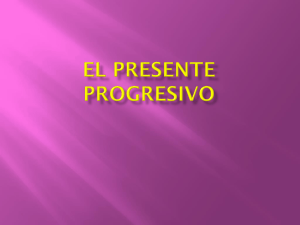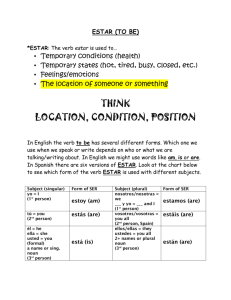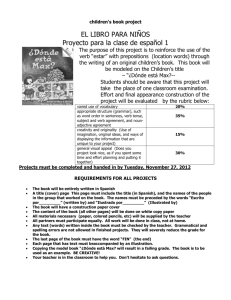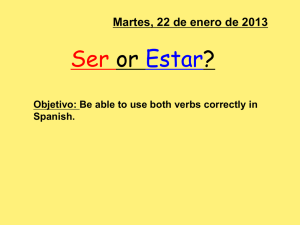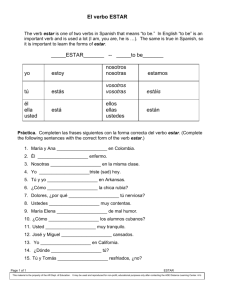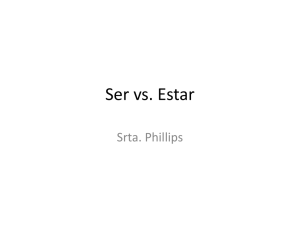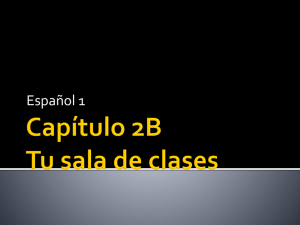Capítulo 2B Tu sala de clases
advertisement
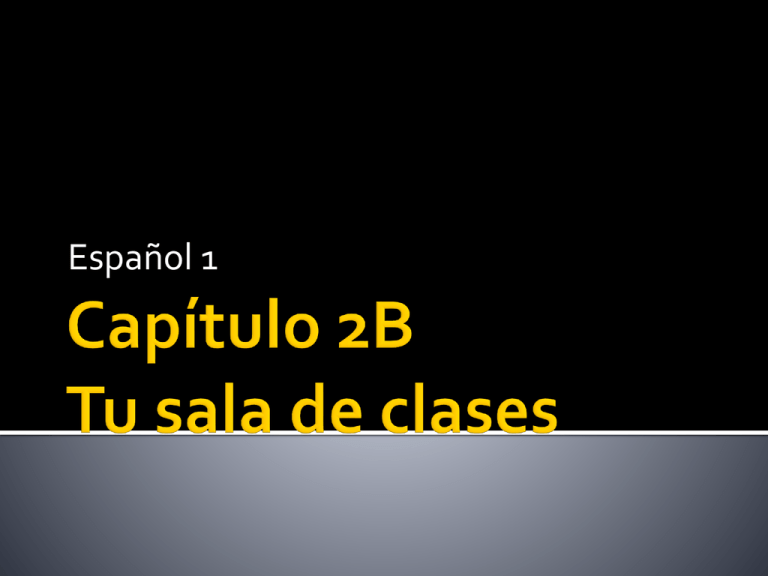
Español 1 1. Choose a Spanish-speaking country. You are going to be responsible for doing several activities in this chapter on this country. Do these activities on the same Google Doc. http://www.worldatlas.com/spanish.htm 2. Do a quick search and find: Where is this country located? What’s the capital? What’s the current population? Describe a classroom Indicate where things are located Talk about more than one object or person Understand cultural perspectives on school Learn about the Spanish-speaking countries El reloj El sacapuntas El escritorio El cartel el ratón el teclado el gabinete (file cabinet) la silla la puerta la papelera/ el bote de basura la bandera la computadora las ventanas la pantalla la mesa la computadora portátil la memoria USB Vocabulario en contexto- páginas 100101 Marcar los objetos de la clase con papelitos (stripes of paper) www.phschool.com jcd-0297 Completa las actividades en tus apuntes: Actividad 4 Actividad 5 Repaso del Capítulo 2A ¿Cuáles son las palabras de vocabulario? 1. México, España y los Estados Unidos 2. hora (time) 3. sentar (sit down) 4. ver 5. escribir 6. lápiz I would like WSCA to require school uniforms. www.socrative.com Socrative App What are the pros and cons of school uniforms? www.socrative.com Socrative App Leer el fondo cultural en la página 106 ¿Los chicos en las escuelas públicas en tu país (country) necesitan uniformes? It will be cumulative: preliminary chapter, Chapters 1A, 1B, 2A and 2B. You will have 37 multiple choice questions and 38 questions that require one-word answers. (75 points) (Thursday, December 11) You will answer one question in five or more sentences. You will receive the questions about two weeks before the exam and I’ll will randomly pick one on the exam day. (25 points) (Tuesday, December 16) 1. Carlos ________ dos lenguajes. a. hablar b. hablamos c. habla D. hablo 2. What word doesn’t belong in the group. ____________ la maestra la estudiante la amiga el Sr. 3. What is the Spanish subject pronoun for the first person singular? ____________ 4. Conjugate the verb estudiar in the nosotras form. _________ 5. Translate windows in Spanish. _____________ We learned how to conjugate regular –ar verbs in the present tense last chapter. Today, you’ll learn how to conjugate your first irregular verb. Do you know why some verbs are irregular? Add the following endings to the stem. Singular Yo -o Tú -as Él -a Ella -a Usted -a Plural Nosotros -amos Nosotras Vosotros(as) áis Ellos -an Ellas -an Ustedes -an 18 These verbs don’t have the same endings attached to the stem. Regular –ar verb endings 0, as, a, amos, áis, an The verb you’ll learn today is estar. Where have you seen this verb before? ¿Cómo estás? ¿Cómo está Ud.? Singular Plural yo estoy (I am) nosotros estamos (we are) nosotras estamos (we are femenine) Tú estás (you are) Vosotros(as) estáis (you all are) él está (he is) ella está (she is) usted está (you formal are) ellos están (they are) ellas están (they are-feminine) ustedes están (you all are) 21 1. To say how you and other people are doing 1. Bien – well 2. Mal – not well 3. Así, así – ok 4. Excelente 22 1. Study the conjugations of the verb estar and the one use from today’s class. Make flashcards of the verbs on your verb conjugation chart (include estar). You may use a free website like Quizlet or index cards. Spanish-speaking country Google Doc 1. What are schools like in your Spanish-speaking country? What time does school start and end? 2. How many classes do students take? What are some subjects they take? 3. In what activities can students participate in? (e.g. sports, clubs, leadership, etc.) 4. What are some major differences you are able to find between the U.S. and your spanishspeaking country? It will be cumulative: preliminary chapter, Chapters 1A, 1B, 2A and 2B. You will have 37 multiple choice questions and 38 questions that require one-word answers. (75 points) (Thursday, December 11) You will answer one question in five or more sentences. You will receive the questions about two weeks before the exam and I’ll will randomly pick one on the exam day. (25 points) (Tuesday, December 16) Please show me your completed flashcards. (10 points) 1. Sr. Pitbull, ¿cómo _________? a. estoy b. estar c. está d. están 2. El verbo estar es un verbo _______. a. irregular b. regular c. fácil d. español 3. ¿Cuál no es una conjugación de estar? a. están b. estóy c. estás d. estoy 4. What’s the correct use for estar? a. to say how old you are b. to describe people c. to say how you are doing d. to say where you live Singular Plural yo estoy (I am) nosotros estamos (we are) nosotras estamos (we are femenine) Tú estás (you are) Vosotros(as) estáis (you all are) él está (he is) ella está (she is) usted está (you formal are) ellos están (they are) ellas están (they are-feminine) ustedes están (you all are) 29 1. To say how you and other people are doing 1. 2. 3. 4. 5. 6. 7. Bien – well Mal – not well Así, así – ok Excelente Cansado(a) – tired Agotado(a) – exhausted Feliz- happy 30 1. ¿Cómo estás? Yo estoy… 2. ¿Cómo está? Él/Ella/ está… (Ud.) Yo estoy… 1. ¿Cómo estamos? Nosotros(as) estamos… 2. ¿Cómo están? Ellos(as) están… 31 Use #2 To say where things are located 32 ¿Dónde está…? ¿Dónde están..? Notice that the third person is only used. 33 Subject + está/están + en + place Complete the following activity on your notes. Libros/Amazon ▪ Los libros están en Amazon. 1. Perro/casa 2. computadora/clase 3. diccionario/mesa 4. mochila/clase de computación 5. bandera/escuela 35 Use #3 To say where you or other people are at 36 Person’s name/subject pronoun + estar + en + place 37 Complete the following activity on your notes. Alicia está en la clase de español 1. Los chicos están en WSCA. 1. Liz/Fresno 2. Mis amigos/Kohl’s 3. Ella/Las Vegas 4. Luis y Alberto/auditorio 5. Yo/ sala de clases 38 Completa las actividades 9, 10 y 12 (preguntas y respuestas) en las páginas 107-108. 1. Study the conjugations for estar and when to use this verb. 2. Complete activities 9, 10 and 12 on pages 107-108. 3. Please take care of you incomplete ASAP. The semester ends on December 19th. Section 2: one word answers 1. Yo soy _________. 2. Los alumnos están en la _________. 3. True or False: Spanish has more subject pronouns that English. 4. What is one way to greet someone in Spanish? 5. Write gracios0(a) in English. 1. Study the conjugations for estar and when to use this verb. 2. Complete activities 9, 10 and 12 on pages 107-108. (10 points) 3. Please take care of you incomplete ASAP. The semester ends on December 19th. It will be cumulative: preliminary chapter, Chapters 1A, 1B, 2A and 2B. You will have 37 multiple choice questions and 38 questions that require one-word answers. (75 points) (Thursday, December 11) You’re allowed to use one side of a 3x5 index card with notes for the written portion. You will answer one question in five or more sentences. Please open the pdf on my website. Section 2: one word answers 1. What is the correct ending for the stem escrib-? 2. What’s the indefinite article for carpeta de argollas? 3. Roberto ________ (estar) en Target. 4. Write bye in Spanish. 5. How many steps are there in conjugating regular –ar verbs in the present tense? You have 2o minutes to write your answer for the following question. Please remember that you must have five sentences in Spanish and that you won’t be able to use notes. ¿Cómo eres? Go to Google Classroom. You must type accents. Submit the quiz when you’re done. Our second irregular verb is ser. Have you seen this infinitive before? What about the two conjugations soy and es? You have used it to describe yourself, a man and a woman. Ser is an –er verb. Ser is irregular because the endings for regular –er verbs aren’t added to the stem. Singular Plural yo soy (I am) nosotros somos (we are) nosotras somos (we are femenine) tú eres (you are) vosotros sois (you all are) vosotras sois (you all arefeminine) ellos son (they are) ellas son (they are-feminine) ustedes son (you all are) él es (he is) ella es (she is) usted es (you formal are) 52 When is ser used? It’s “to be” in English. To describe a person, place or thing Practice the conjugations for ser. See the PDF on my website. Study for the semester final. Review your notes on the verb ser. Google Classroom Write a five sentence paragraph in Spanish describing a famous person of your choice. Please write the person’s name on the bottom of the page. The verb is used to: 1. describe a person. ▪ Ella es americana. ▪ Tú eres de Citrus Heights. 2. explain who a person is. ▪ Nosotros somos policías. ▪ Yo soy maestra. To say where a person is from use: ser (must conjugate verb) + de + place Examples: Yo soy de Puerto Rico. Tú eres de __________. La Srta. Serrano es de Merced. Javier y Bernardo son de ___________. What’s the formula used to say where people are from? ser (must conjugate verb) + de + place 1. ________ son _____ Maryland. 2. Alicia _____ _____ Fresno. 3. Nosotras somos ______ de California. 4. Betty _____ de los Estados Unidos. 5. ______ es de _________. Fill in the blanks with the correct subject pronoun or verb conjugation of ser. 1. Nosotras __________ de Nueva York. 2. _______ eres de Boston. 3. Uds. _______ de España. 4. _________ son de México. 5. Los chicos ________ de Brasil. 6. Él ______ de Citrus Heights. 7. ______ soy de Chile. ¿De dónde son? 1. él/ Los Ángeles 2. Carmen y yo / Perú 3. Nosotros / México 4. Luisa y Lorena / Colombia
